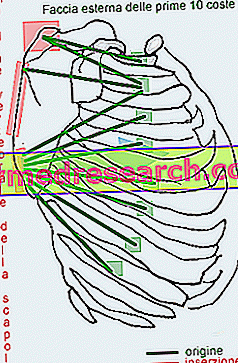
The serratus anterior muscle, or large dentate, is located in the lateral wall of the thorax. It originates with 9-10 digits from the outer face of the first 10 ribs. It is inserted from the upper corner to the lower corner of the vertebral margin of the scapula and due to this long it is commonly divided into three parts: an upper part that originates from the first 10 ribs and is inserted at the upper scapular angle; an intermediate part which originates from the 2nd to the 4th ribs and is inserted along the medial margin of the scapula; an inferior one that originates from the 5th to the 9th or 10th ribs and is inserted at the lower margin of the scapula.
With its action it elevates the ribs (inpiratory muscle); abducts and externally rotates the scapula; makes the scapula adhere to the chest (synergistic action with the rhomboid muscles) and has a very important role in the anteversion of the arm. It works with the upper and lower trapezium beams in the elevation of the arm on the frontal plane (from 90 ° to 150 °) and on the sagittal plane (from 60 ° to 120).
If particularly weak it can lead to the detachment of the shoulder blades from the rib cage (winged shoulder blades). This function is synergistic with that exercised by the rhomboid muscles.
It is innervated by the long thoracic nerve of the brachial plexus (C5-C7).
| ORIGIN External face of the first 10 ribs |  |
| INSERTION From the upper corner to the lower corner along the entire vertebral margin of the scapula. | |
| ACTION Elevate the ribs (inspiratory muscle); abducts and externally rotates the scapula; makes the scapula stick to the chest. Lower and place the shoulder. | |
| INNERVATION LONG THORACIC NERVE of the brachial plexus (C5-C7) |
| Upper limb | Lower limb | Trunk | Abdomen | Articles |


